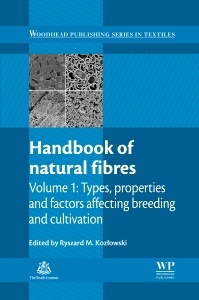Description
Handbook of Natural Fibres
Volume 1: Types, Properties and Factors Affecting Breeding and Cultivation
The Textile Institute Book Series
Coordinator: Kozlowski Ryszard M.
Language: English
Subjects for Handbook of Natural Fibres:
Publication date: 10-2018
656 p. · 15.5x23.2 cm · Paperback
Replaced by new edition: Access to the new edition.
Publication date: 10-2012
656 p. · 15.5x23.3 cm · Paperback
Replaced by new edition: Access to the new edition.
Description
/li>Contents
/li>Biography
/li>Comment
/li>
Part one reviews key types and fundamental properties of natural textile fibres. The production, identification and testing of a range of cotton, bast, silk and wool fibres are discussed, alongside bioengineered natural textile fibres. Part two goes on to explore the improvement of natural fibre properties and production through breeding and cultivation, beginning with a discussion of fibrous flax and cotton. Improved natural fibre production through the prevention of fungal growth is explored, along with the use of genetic engineering and biotechnology to enhance desirable characteristics. Finally, the wider impact of natural textile production is discussed, using wild silk enterprise programs as an example.
With its distinguished editor and international team of expert contributors, the two volumes of the Handbook of natural fibres are essential texts for professionals and academics in textile science and technology.
Contributor contact details
Woodhead Publishing Series in Textiles
Dedication
Part I: Fundamentals: types of fibre, properties, identification and testing
Chapter 1: Introduction to natural textile fibres
Abstract:
1.1 Introduction
1.2 Historical background of natural fibres
1.3 Handbook of natural fibres
Chapter 2: Cotton fibres
Abstract:
2.1 Introduction
2.2 The cotton plant
2.3 Cotton fibre structure
2.4 Physical properties of cotton
2.5 Measuring cotton quality
2.6 Future trends
2.7 Acknowledgement
Chapter 3: Bast fibres: jute
Abstract:
3.1 Introduction to jute
3.2 Types of jute
3.3 Fibre morphology
3.4 Chemical composition
3.5 Properties of jute
3.6 Typical applications
3.7 Conclusions
Chapter 4: Bast fibres: ramie
Abstract:
4.1 Introduction to ramie
4.2 Types of ramie
4.3 Fibre morphology
4.4 Properties of ramie
4.5 Typical applications
4.6 Conclusions
4.7 Sources of further information and advice
Chapter 5: Bast fibres: flax
Abstract:
5.1 Introduction
5.2 Flax plant morphology
5.3 Structure and chemical composition of flax
5.4 Flax harvesting
5.5 Degumming
5.6 Scutching
5.7 Hackling (combing)
5.8 'Cottonization'
5.9 Spinning
5.10 Bleaching, dyeing
5.11 Finishing
5.12 Recapitulation
5.13 Conclusions and future trends
5.14 Sources of further information and advice
Chapter 6: Bast fibres: hemp cultivation and production
Abstract:
6.1 Introduction
6.2 The hemp plant
6.3 Hemp cultivation
6.4 Retting
6.5 Fibre extraction
6.6 Hemp fibre spinning
Chapter 7: Silk fibres
Abstract:
7.1 Introduction
7.2 Silk industry
7.3 Microstructure and appearance
7.4 Amino acid composition
7.5 Properties of silk
7.6 Applications of silk
7.7 Future trends
7.8 Conclusions
7.9 Sources of further information and advice
Chapter 8: Wool fibres
Abstract:
8.1 Introduction
8.2 The effects of the economy on wool
8.3 Wool production
8.4 Chemistry and morphology
8.5 Properties of wool
8.6 Industrial usage of wool
8.7 Branding and consumer friendliness
Chapter 9: Mohair, cashmere and other animal hair fibres
Abstract:
9.1 Introduction
9.2 Alpaca
9.3 Angora rabbit hair
9.4 Camel
9.5 Cashgora
9.6 Cashmere
9.7 Guanaco
9.8 Llama
9.9 Mohair
9.10 Musk-ox
9.11 Vicuña
9.12 Yak
9.13 Other animal hair fibres
9.14 Acknowledgements
Chapter 10: Bioengineered natural textile fibres
Abstract:
10.1 Introduction
10.2 Bacterial cellulose
10.3 Enzymatic treatment of cellulose
10.4 Future trends
10.5 Conclusions
10.7 Appendix: abbreviations
Chapter 11: Identification of natural textile fibres
Abstract:
11.1 Introduction
11.2 Natural textile fibres
11.3 Identification methods
11.4 Practical approach
11.5 Forensic analysis
11.6 Future trends
11.8 Appendix: abbreviations
Chapter 12: Testing of natural textile fibres
Abstract:
12.1 Introduction
12.2 Key issues in testing natural fibres
12.3 Test methods for natural fibres
12.4 Measuring the physical properties of natural fibres
12.5 Chemical properties
12.6 Instrumental methods
12.7 Future trends
12.10 Appendix: abbreviations
Part II: Improving natural fibre production through breeding and cultivation
Chapter 13: Developments in fibrous flax breeding and cultivation
Abstract:
13.1 Introduction
13.2 Key issues of fibre flax breeding and cultivating
13.3 Methods of flax and linseed breeding
Conclusions
Conclusions
13.4 Modern methods in flax and linseed breeding
13.5 Sources of further information and advice
13.7 Appendix: abbreviations
Chapter 14: Cotton breeding and agro-technology
Abstract:
14.1 Introduction
14.2 Genetic review
14.3 Breeding methodology
14.4 Agronomy and physiology
14.5 Breeding targets
14.6 Future trends
14.7 Conclusions
14.8 Sources of further information and advice
14.10 Appendix: abbreviations
Chapter 15: Fibre flax cultivation in sustainable agriculture
Abstract:
15.1 Introduction to fibre flax for sustainable agriculture
15.2 Flax growth cycle
15.3 The role of cultivars in sustainable flax cultivation
15.4 The importance of crop rotation
15.5 Flax cultivation requirements
15.6 Flax harvest
15.7 Future trends in fibre flax growing for sustainable agriculture
Chapter 16: Prevention of fungal growth in natural fibres
Abstract:
16.1 Introduction
16.2 Key issues of fungal growth, especially mildew, in natural fibres
16.3 Methods of preventing fungal growth, especially mildew, in natural fibres
16.4 Future trends
16.5 Conclusion
Chapter 17: Genetic engineering and biotechnology of natural textile fiber plants
Abstract:
17.1 Introduction: global status of commercialized biotech crops
17.2 Fibrous biotech crops
17.3 Future trends
17.4 Conclusions
17.5 Sources of further information and advice
17.7 Appendix: abbreviations
Chapter 18: Wild silk: wild silk enterprise programs to alleviate poverty and protect habitats
Abstract:
18.1 Introduction
18.2 Definition of silk
18.3 Silk structure and function
18.4 Wild silk enterprise
18.5 Wild silk enterprise versus alternative conservation and poverty alleviation programs in Madagascar
18.6 Conclusion
Note
Index
- Provides an essential guide to a wide range of natural fibres and highlights key techniques for their improvement
- Reviews key types and fundamental properties of natural textile fibres, addressing the production, identification and testing of a range of cotton, bast, silk and wool fibres
- Explores the improvement of natural fibre properties and production through breeding and cultivation, beginning with a discussion of fibrous flax and cotton




